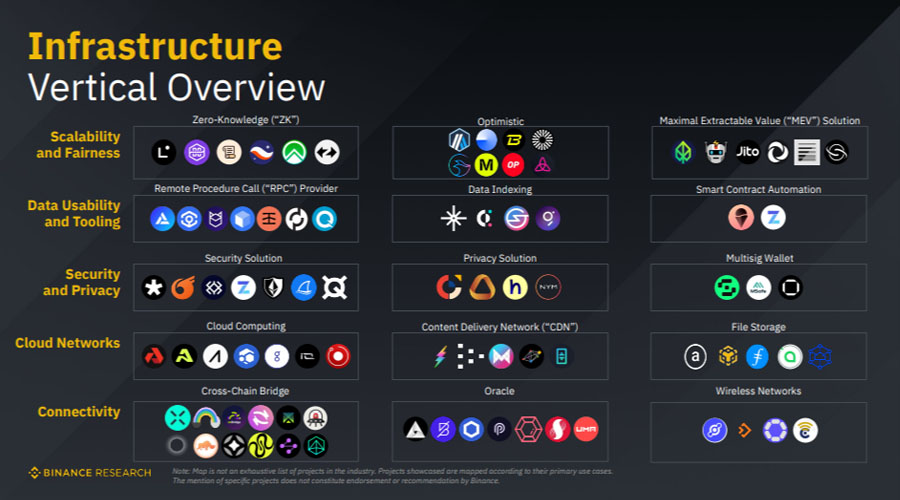Evgen verzun
Blog
October 3, 2024
Top Projects in Infrastructure - First Part of the Binance Industry Report

On September 20, Binance Research released their Industry Map, outlining the most promising sectors and projects in the crypto space. In this article, we’ll focus on the first part of the report: Infrastructure, which is the backbone of the entire crypto ecosystem. Infrastructure plays a critical role in enabling blockchains to scale, stay secure, and seamlessly connect with each other. Here’s what you need to know about the key areas of innovation and the top projects leading the charge in blockchain infrastructure.
1. Infrastructure: The Backbone of Crypto
The infrastructure sector is the foundational layer that keeps the entire crypto ecosystem running smoothly. Without it, none of the applications, DeFi protocols, or NFTs would function. Binance’s latest report outlines five key areas of innovation within the infrastructure space, each designed to improve the efficiency, scalability, security, and connectivity of blockchains.
Key Areas of Innovation in Infrastructure

Key Areas of Innovation in Infrastructure (Brief Overview)
- Scalability & Fairness
Improving transaction speed by batching them off-chain and ensuring fairness through solutions like Maximal Extractable Value (MEV) management.
- Security & Privacy
Enhancing blockchain security and user privacy through protocols that prevent data tracking and protect against smart contract hacks.
- Connectivity
Building cross-chain bridges that allow different blockchains to seamlessly communicate and transfer assets.
- Cloud Networks
Decentralized cloud storage and computing solutions, reducing reliance on traditional cloud providers and offering more secure, distributed services.
- Data Usability & Tooling
Making blockchain data easier to use by improving data indexing and querying tools, enhancing developer experience and application potential.
Top Projects in Infrastructure
1. Polygon zkEVM (Scalability & Fairness) Polygon’s zkEVM is a Layer-2 (L2) solution for Ethereum that uses zero-knowledge (ZK) proofs to batch transactions off-chain, offering faster transaction finality and reduced costs. It's designed to help Ethereum scale while maintaining high security, and it's gaining significant attention for its ability to provide faster, cheaper transactions.
2. zkSync Era (Scalability & Fairness) zkSync Era is another leading L2 solution for Ethereum, focused on solving the network’s scalability issues. By using ZK rollups, zkSync allows for thousands of transactions to be processed at a fraction of the cost, making Ethereum more accessible to users and developers.
3. StarkNet (Security & Privacy) StarkNet is a decentralized ZK rollup that aims to bring privacy and scalability to decentralized applications (dApps). It allows developers to build secure and scalable dApps on Ethereum, with the added benefit of zero-knowledge proofs to enhance privacy and security.
4. Render Network (Cloud Networks) The Render Network provides a decentralized cloud computing platform that enables users to share spare GPU resources to render high-performance tasks such as graphics and video. It is one of the leading projects in decentralized cloud computing, supporting industries like gaming, AI, and media.
5. Arweave (Cloud Networks) Arweave offers permanent and decentralized data storage, which is particularly important for preserving critical information in an immutable way. It’s a leading project in the decentralized storage space, providing users with a secure alternative to traditional cloud storage providers.
6. Cosmos IBC (Connectivity) Cosmos has built the Inter-Blockchain Communication (IBC) protocol, a system designed to connect multiple blockchains and enable them to exchange data and tokens. This cross-chain solution allows different blockchains to work together, expanding the possibilities for developers and users to create more integrated and versatile applications.
7. Filecoin (Data Usability & Tooling) Filecoin is a peer-to-peer network that provides decentralized storage, allowing users to store, retrieve, and manage data without relying on centralized providers. Its focus on making blockchain data more accessible has made it a leader in the data usability space, with a mission to decentralize the world’s data storage.
Why Infrastructure Matters?
The innovations in infrastructure are fundamental for the continued growth and success of the entire crypto space. As scalability improves, more people can use blockchains without congestion or high fees. Security and privacy improvements will protect users and their assets, while better connectivity and data usability make it easier for developers to build and users to interact with decentralized applications.
With the rise of decentralized cloud networks and improved blockchain interoperability, the infrastructure projects listed here are paving the way for the future of crypto. As adoption continues to grow, the importance of these foundational technologies will only increase.
🔗 Want to explore more? Check out Binance’s full Industry Map report for detailed insights on these projects and more here.